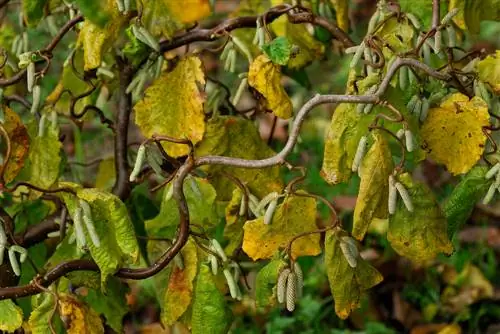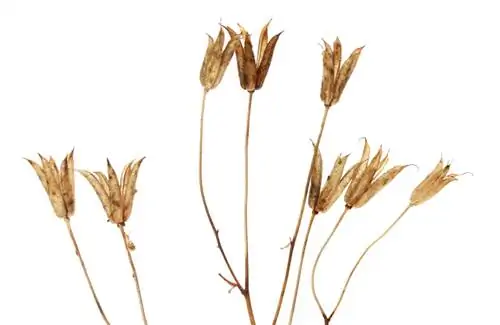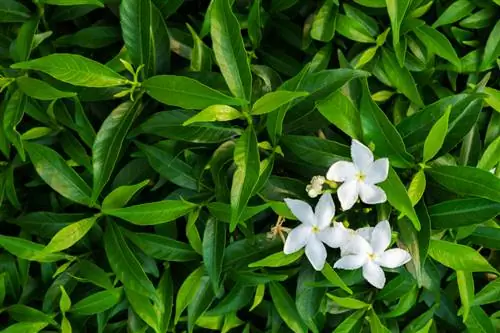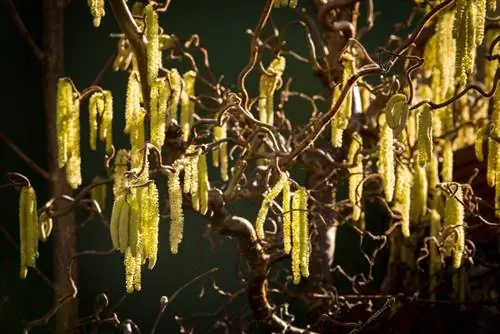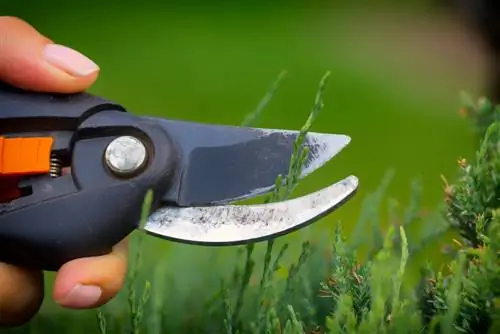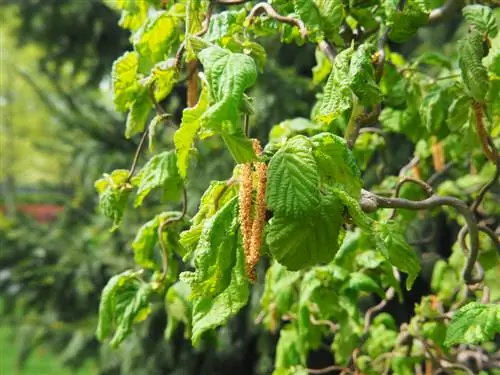- Author admin [email protected].
- Public 2023-12-25 17:45.
- Last modified 2025-01-23 11:21.
With its bizarrely twisted branches, the corkscrew hazel is a real curiosity among ornamental trees. It is not entirely clear where the strange branch deformation comes from. What is certain, however, is that with its structurally rich shrubbery it creates a whimsical, romantic image in the garden.
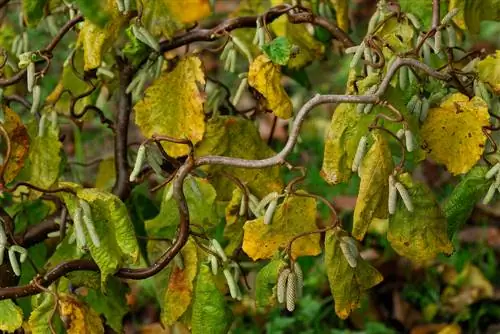
What is a corkscrew hazel and what conditions does it need?
The corkscrew hazel (Corylus avellana 'Contorta') is an ornamental shrub variant of the common hazel with characteristically twisted branches and slightly curled leaves. It can grow 4 to 6 meters high and 2 to 4 meters wide and prefers a sunny to partially shaded location with nutrient-rich, humus-rich and moist soil.
Origin
The corkscrew hazel is a modified variant of the common hazel, Corylus avellana. Its botanical variety name is Corylus avellana 'Contorta'. Unlike the corkscrew willow, which has similarly twisted branches but otherwise has a different habit, the corkscrew hazel is not a targeted breed. Rather, it is a freak of nature. Experts do not entirely agree on whether a spontaneous mutation, i.e. a genetic error, or a disease that does not further affect the shrub is responsible.
This wondrous hazel form was first discovered and described in England around 1900. Impressed by the striking branch structure, people have long since begun to specifically refine the shape. The common hazel is usually used as a base.
Just like the corkscrew willow, which is sometimes confused with the corkscrew hazel due to the similarity of its branch structure and name, the corkscrew hazel is currently experiencing a real boom in gardens. Above all, you not only enjoy the original branch structure directly on the bush, but you also like to use individual branches as purist decoration in the vase.
Origin at a glance:
- Bizarrely twisted branches either spontaneous mutation or harmless disease
- First discovered and described around 1900 in England
- Today, targeted “production” of the corkscrew hazel through refinement
- Currently very popular again
Growth
In terms of basic habitus, the Corylus avellana 'Contorta' does not differ significantly from the common hazel. Like them, it also grows as a multi-stemmed, upright shrub with quite rich, sympodial branching. With rapid growth, the corkscrew hazel can reach 4 to 6 meters in height and around 2 to 4 meters in width. As you age, your crown can become quite expansive and slightly overhanging.
Their most characteristic and striking feature are of course their corkscrew-shaped branches, which look very decorative not only on the bush, but also when cut. Especially during the leafless period over the winter, the twisted branches can create a striking structural accent in the garden.
The corkscrew hazel can live up to 100 years.
Growth characteristics in keywords:
- Like common hazel, upright, multi-stemmed shrub growth
- Fast growth, up to 6 m high and around 4 m wide
- Corkscrew-like branches
- Age up to 100 years
leaves
The leaves are also marked by the mutation or disease that gives the corkscrew hazel its name and its special status: because they are not as smooth and straight as those of the common hazel. They show a slightly curled, wrinkled structure and thus take up the motto of the branch.
In terms of size, color and edge structure, they do not differ from the leaves of the common hazel: they also have a typically rounded, pointed shape with a double-serrated edge and a light green color. Its texture is finely veined, but appears coarser due to the curl. The surface is slightly hairy. They attach alternately to the branches. In autumn the leaves turn yellow like the common hazel and are completely shed in winter.
Leaf properties in brief:
- Are also marked by the mutation or disease and show a curly structure
- Size and shape like common hazel: roundish, tapered at the front, double-serrated edge
- Light green color, slightly hairy
- Yellow autumn color, complete shedding of leaves towards winter
Flowers
Like its original form, the corkscrew hazel is monoecious - so both male and female flowers are formed on one specimen. The male flowers are produced in autumn and then form the hazel-typical, greenish-yellowish catkins at the end of winter. The female flowers remain enclosed in the bud and have a reddish tip.
In windy weather, the pollen is spread into the surrounding area - this can lead to severe symptoms for those suffering from hay fever in February and March. However, bees are even happier about the early source of food in the year.
Flowers in keywords:
- Corkscrew hazel is monoecious with male and female flowers on one specimen
- Male flowers in catkin shape, female flowers budded with reddish tip
- Flowering period in February to March
- Pollen allergenic, but an important source of food for bees in the early year
Fruit
Hazelnuts have been valued as a tasty and nutritious natural gift by both people and many animals for thousands of years. Like the common hazel, the corkscrew hazel also produces the typical nut fruits from September onwards, although to a somewhat smaller extent. In addition, the nuts remain smaller, are not quite as tasty and the consistency is not as crunchy and tender, but rather woody.
Therefore, the corkscrew hazel is primarily used as an ornamental shrub. If you would like to harvest a lot of your own hazelnuts, you should opt for a common hazel. It takes a corkscrew hazel about 10 years to reach fruit maturity.
Fruits at a glance:
- Less productive than common hazel
- Nuts also less tasty
- It is better to plant common hazel for a good nut yield
Which location is suitable?
The corkscrew hazel prefers a sunny to semi-shady place in the garden. The sunnier the location, the more vitally it thrives.read more
What soil does the plant need?
The soil for the corkscrew hazel should ideally be nutrient-rich and humus-rich, as well as well-drained and moist. The pH value should be in the high range. The corkscrew hazel also likes its feet to be warm - so it is advantageous if the sun can reach its base and the location is relatively close to other trees or to the house. In general, the corkscrew hazel is quite tolerant when it comes to site conditions.
When planting grafted corkscrew hazels, it is important to place the root ball a little deeper in the planting hole so that the grafting point is underground. In this way you avoid straight wild shoots growing out, which disrupt the appearance of the characteristically winding branches and, above all, quickly overgrow it. You do not need to take this measure to heart with unrooted corkscrew hazels, but such specimens are hard to come by.
To remember:
- Soil for corkscrew hazel as nutrient-rich and humic as possible
- Well-drained and moist
- As warm as possible
- ph value rather high
The correct planting distance
The corkscrew hazel still needs to keep a little distance from neighboring plants so that its flat, extensive root system can develop well. It also looks very good as a solitaire. You should leave a radius of around 2 meters around the bush.
How do I transplant correctly?
If possible, you should not transplant a corkscrew hazel. Digging up and moving it to another location means a lot of stress for the shallow-rooted shrub, which should be avoided if possible. However, if you want or have to implement it for space or neighborhood reasons, you should only do this with a young specimen. The shrub should not be older than 5 years, otherwise it will have become too established in its location.
The best time to transplant is early spring before the leaves emerge. In addition, there should be no frost.
When transplanting, it is important to generously dig out the extensive root system. This is of course a lot of work, but the less root mass you cut off the corkscrew hazel, the better. The new planting hole should have twice the volume of the root ball and be lined with sandy soil drainage. After inserting, fill the hole with humus-rich soil, tamp it down well and water vigorously. A support post for stabilization is recommended.
To compensate for the inevitable loss of roots, you should also cut the bush back a little.read more
Watering corkscrew hazel
A corkscrew hazel outdoors only needs special watering when planting and during long dry periods in summer. Then you should water them thoroughly once.
If you keep them in a pot, regular watering is of course essential.
Fertilize corkscrew hazel correctly
Since the corkscrew hazel requires a lot of nutrients, it is recommended to give it a little extra energy every now and then. For a specimen in the open field, good, ripe compost is best suited for this, which you can easily work into your planting soil in spring.
You should provide a corkscrew hazel in a pot with liquid fertilizer about every 2 weeks during the growing season from March to September.
Cut corkscrew hazel correctly
The corkscrew hazel does not normally need any pruning care - after all, it is valued for its characteristic growth. In addition, it thrives better and more willingly if it is allowed to grow in peace. However, if you move the shrub in its first few years, pruning is recommended after the transplanting procedure.
Another exception is when wild shoots form from the planting ground. This happens quite easily, especially with refined specimens. It can also occur in unrooted individuals, but is much rarer. If you notice shoots shooting up into the bushes, this is not a harmless aesthetic nuisance - because the wild shoots are very vigorous and can quickly overgrow the mutated branch structure.
In order to maintain the characteristic appearance of your corkscrew hazel, you should quickly pick up the scissors in this case. Place them as close to the ground as possible to the wild shoots growing below and be thorough when identifying them.
A radical pruning of old, bald specimens is also possible.
Cutting rules at a glance:
- Corkscrew hazel does not need any pruning care
- 1. Exception: After any transplanting
- 2. Exception: Formation of wild shoots that disrupt the characteristic branch pattern and overgrow - cut off close to the ground
- Radical pruning possible in old individuals
read more
Propagate corkscrew hazel
Propagate a corkscrew hazel is not entirely trivial because in gardens it is usually a refined specimen. The rooting of grafted plant parts is therefore somewhat difficult. However, you can try using the cutting method or the sinking method.
Cuttings
Cut a young, unwoody shoot that has about 4 to 6 leaves from the upper, inner crown of the bush. Ideally, you should make the incision directly below one eye. Remove all but the top two leaves and place the prepared cutting either in a planter with a peat-sand mixture or in a glass of water. The location should be bright and warm.
Lowers
The thin, flexible branches of the corkscrew willow, which are set far down, can also be used to lay downers. Choose a shoot that is growing on the outside and is as young as possible (which of course should not be a wild shoot) and place it in a previously dug notch in the ground. Fix it at the curved target growth point with a metal hook. Then raise the shoot tip upwards and stabilize it with a wooden stick. A wound cut at the site of growth can be helpful.
Pests
Apart from the harmless diseases that give it its typical appearance, the corkscrew hazel is largely immune to diseases. However, it can certainly be plagued by species-specific parasites. This includes, above all, the hazelnut borer, which is also an annoying pest for the common hazel. It destroys the harvest by laying eggs and developing larvae in the fruits. The nuts then appear correspondingly perforated.
The weevils are relatively difficult to fight. Chemical insecticides against the parasite are not permitted in private gardens. If there is an infestation, you should first collect the adult beetles by hand or shake them off the bush and release them far away from your garden. The infected nuts are also collected and disposed of as thoroughly as possible, preferably burned. To prevent the hatched larvae from surviving in the soil over the winter, cover the planting base with a garden fleece in the fall.
As a preventative measure, you can also hang a glue ring (€9.00 on Amazon) in the bush.
Tip
If you want to save yourself from having to frequently remove wild shoots, when buying a refined corkscrew hazel, choose a specimen with Turkish tree hazel as a base. Such variants are less prone to wild shoots than those based on common hazel. If you would like to get a tall corkscrew hazel, variants grafted onto tree hazels are also available.
Varieties
A special breeding form of the corkscrew hazel is offered in the plant trade primarily in the form of the Corylus avellana 'Red Majestic'.
Corylus avellana ‘Red Majestic’
The variant, also known as the “red-leaved corkscrew hazel” or blood corkscrew hazel, is definitely worth considering as an alternative to the normal Corylus avellana - because, as its common names suggest, it has a very special charm thanks to its deep, dark red foliage. The male catkin flowers of this variety also have a reddish color. Like the normal corkscrew hazel, the flowering period is in February and March.
In terms of growth, the red-leaved corkscrew hazel is slightly smaller than the wild species and the green-leaved corkscrew hazel - it only grows to around 2.50 m high, but is around 3 m wide thanks to its bushy branching.

